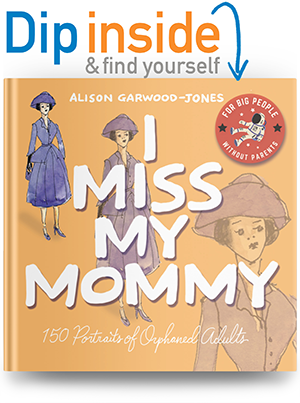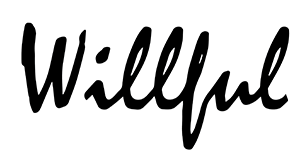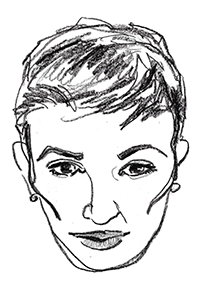The long goodbye …
February 2, 2010
I got a lot of moving feedback the first time I wrote about my mother, Catherine, here in The Long Goodbye, published four years ago on this blog. After she died in December 2012, I expanded on the story of our relationship and turned it into a magazine piece for Glow Magazine. You can read that version here. I dedicate my work to my brothers, Peter and Richard.

My mother knew her entire adult life what was coming. But confirmation arrived the day she shuffled into the kitchen, swung open a few cupboard doors, then turned to me and asked, “Where are the singing noodles?” From that day forward, I stopped leaning on mum and started extending a protective hand. Before long, pots began appearing in the oven, car keys in the fridge, and sticky notes with basic English words started multiplying across every surface of the house — all quirks of the onset of Alzheimer’s.
Nothing erases human nature like Alzheimer’s. The imprint of the disease is the same in everyone who gets it. They all disappear down the same path, exhibiting more or less the same set of behaviors. Most go from nervous fusspots crying “No, no, no” (the last word in their drained vocabulary) to silent bodies with gawping mouths and fixed stares. Mum’s mum gave her a preview of what was in store before she died of the disease thirty-five years ago. That’s why I prefer to think about what made my mother unique before age flicked a switch inside her body and unleashed this great leveler.
For someone born before the Crash of ’29 my mother had a remarkably liberal view of a woman’s place in the world. By the time I came along she was already in her early 40s and so excited to have a girl, after two boys, that she later told me she regularly whispered in my infant ears, “Ah, someone who’ll understand.” Right from the start, she knew we’d be confidantes and that we’d have each other’s backs until the end.
One thing that set my mother apart was that, once I was out of the house, she never ever tapped on her watch and asked, Where are my grandchildren? To me or my brothers. Her own struggles to conceive sensitized her to this loaded topic. But it was more than that. She had this rare ability to honour the life of the individual. That meant that other people’s unconventional choices never sent her into a tailspin. Not like some women in the neighbourhood.
In her day, of course, women attached themselves to men like the stateless to life boats, their fortunes rising and sinking with their rescuers. All too often, you married the man you wanted to be: aspiring novelists teamed up with practicing writers (becoming their first readers, typists, editors, and, sometimes, their ghost writers) while nurses said “I do” to doctors, and vowed to always pass the scalpel but never perform with it. Mum, on the other hand, believed in developing a person’s potential, not thwarting it. So when I grew up and decided that filling a blank page constituted a large chunk of my identity, she was right there with me. She didn’t go out of her way tutor me about love, and I think that was deliberate. At that point I had no interest in living an integrated life. What were guys to books? When we did talk men, she just smiled, looked me in the eye and said, “You”ll have to figure that one out on your own.” Confounding, but true.
All the while she kept feeding and watering my individuality, so that every time I came home to visit my parents at Christmas or Spring Break, there was a new book at the end of my bed touching on one of my many interests: painting, history, culture, biography. Those books have moved with me to every house I’ve lived in since university. There’s the doorstopper, Paintings in the Musée d’Orsay, the elegant Complete Guide to Chinese Brush Painting Techniques and Anne Morrow Lindbergh’s Gift from the Sea, an ode to the many forces that shape a woman’s life.
Mum expressed a lot of things before Alzheimer’s pulled her under. Because she knew she was about to lose everything the declarations just poured out. “I want you to be happy,” she said, still not serving up a prescription for how I should get there. “I love that guy,” she’d smile, pointing to my dad while he was pushing a grocery cart down the produce aisle or, more likely, watching the Golf Channel. She must have said “I love you” to him more times in her last year (of speech) than in the final two decades of their sixty plus year marriage. Most times, he was too busy staring at the TV, wincing at a missed putt, to hear. But he knew, and we knew because she was telling the whole room, the entire store … no, the entire world. I’m glad I witnessed this as an adult. The romantic in me is forever believing in love’s power to cut through chaos, disappointment and change as it did with my parents. He had her back, and she his.
A few months before we handed mum over to the care of a team of nurses (she was beyond consulting on this), she called me and left a message on my answering machine. Something in me said, This is the last time she’s going to know how to pick up the phone and dial my number. That hunch proved true. I played her message over and over that week, then popped a blank tape in my ghetto blaster and pushed “record” so I’d have her voice with me forever.
It’s been seven years since she left that message and I haven’t listened to the tape since. I can’t. In that moment in time, she put aside her doubt and fear for herself and with a shaky, lilting voice let me know, “I miss you, Alison, and I just wanted to let you know I think about you every day and hope that everything’s going well in Toronto. I love you. Bye.” From the commotion, I could tell she missed placing the receiver in the carriage on the first try. That vulnerability makes my knees buckle every time I think about it.
Goodbye, Instagram. Hello again, WordPress
July 30, 2021
What? You didn’t hear the news?
Instagram’s 3-column scrolling gallery loved by illustrators, photographers and influencers alike is going away.
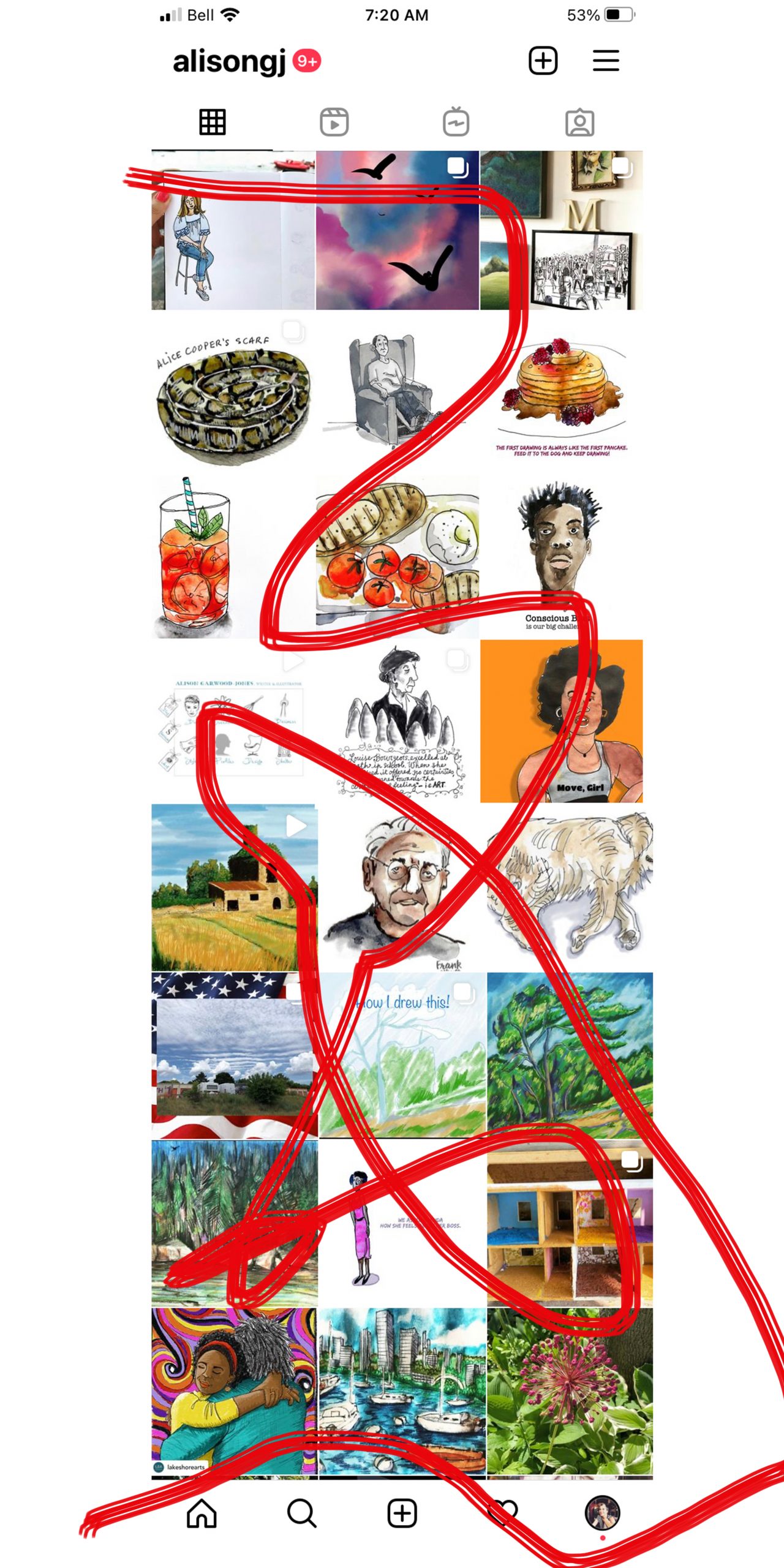
The very thing that makes Instagram unique — its square photo sharing feature (and filters) — is about to be wiped out and replaced by all video all the time.
But why? you ask.

Here’s why: Instagram (owned by Facebook) is being trounced by the video sharing app, TikTok, so it’s creating a clone to compete. Whenever Facebook is not winning it buys or copies the competition.
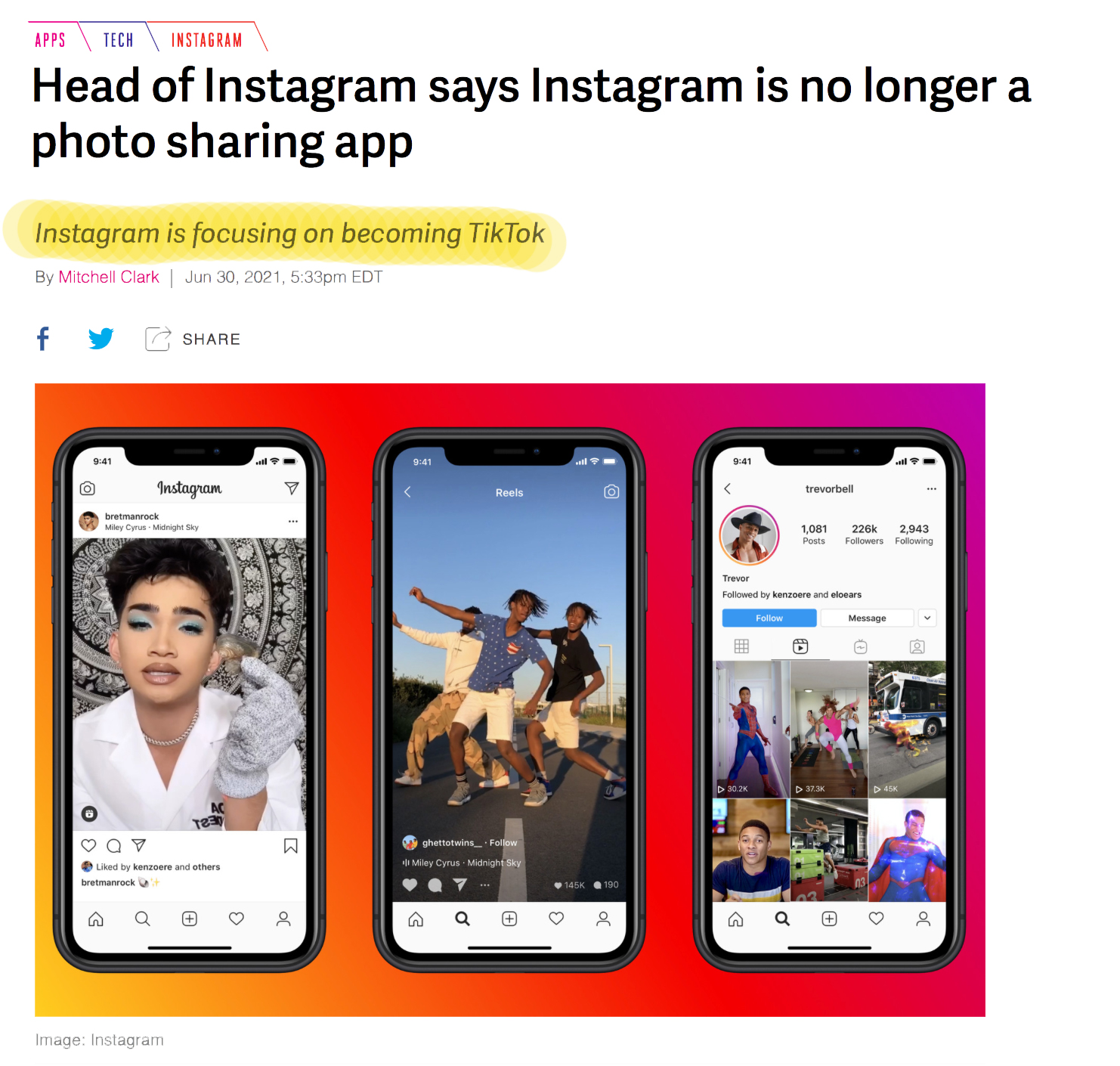
You can read this article here.
If you’re still thinking, “But wait … I like what differentiates Instagram from all the video-sharing apps, and so does everyone I know.”
CEO Mark Zuckerberg knows how you feel, and he doesn’t care.

Here’s the thing: none of what you or I learned in school or in online webinars about audience-first business models applies to Facebook.

Listening to us and serving us has never been a priority. Mark’s measurable objective is total domination (a la Caesar Augustus). Customer feedback doesn’t stand a chance in that headspace.
 Caesar Augustus, Artist Unknown. Vatican Museums, Rome
Caesar Augustus, Artist Unknown. Vatican Museums, Rome
And here is where I admit to slipping up. Despite everything I know about Instagram’s rotten record as an online partner, I got lazy and I let it do my work for me.
Instagram become my Louvre, the main line to my audience.
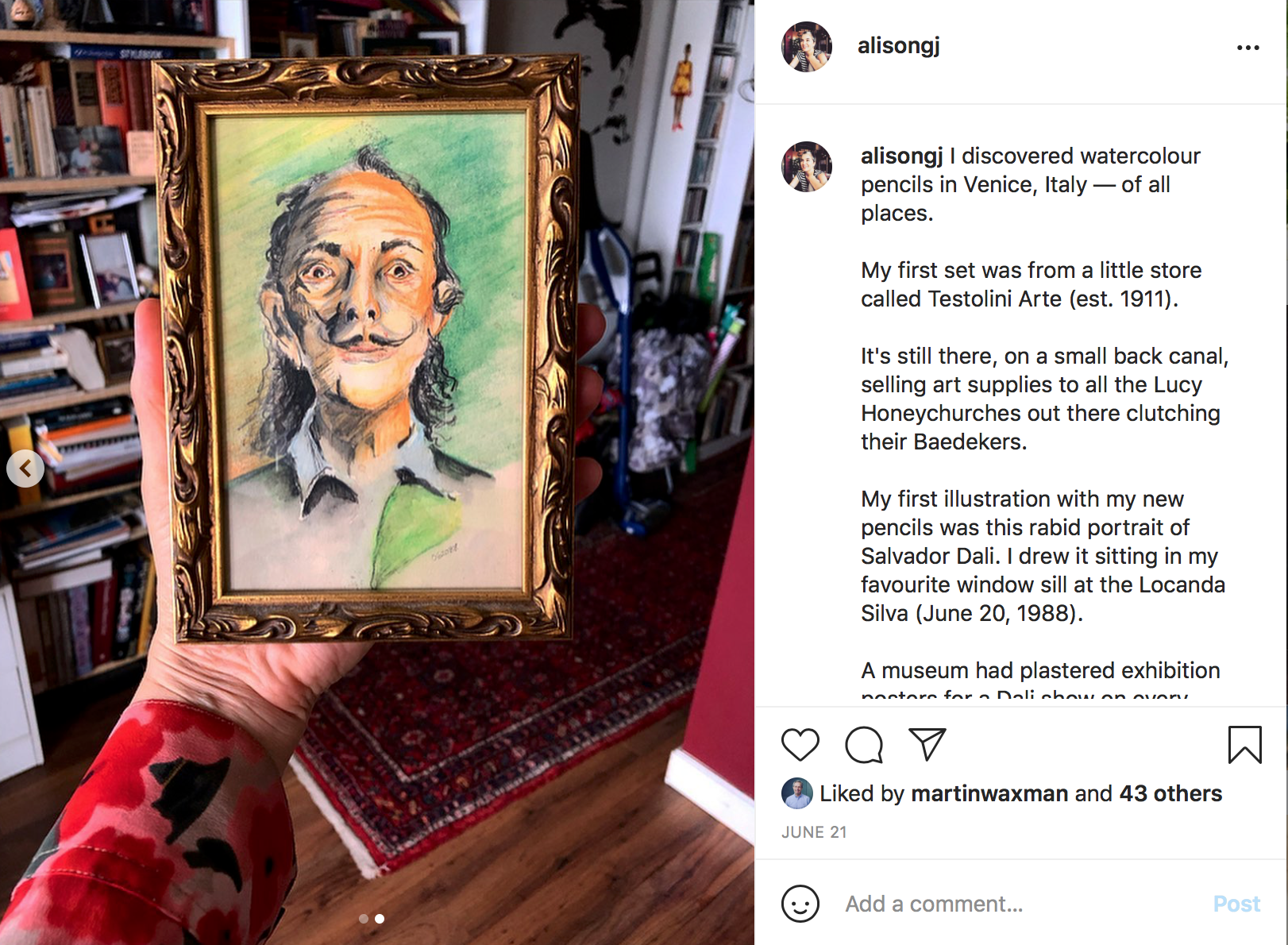
And as I was merrily posting to the Gram, I got lazy and stopped archiving my illustrations on my website, a property I own and control.
To my current and former students: yes, I know better, but I’m human like you.
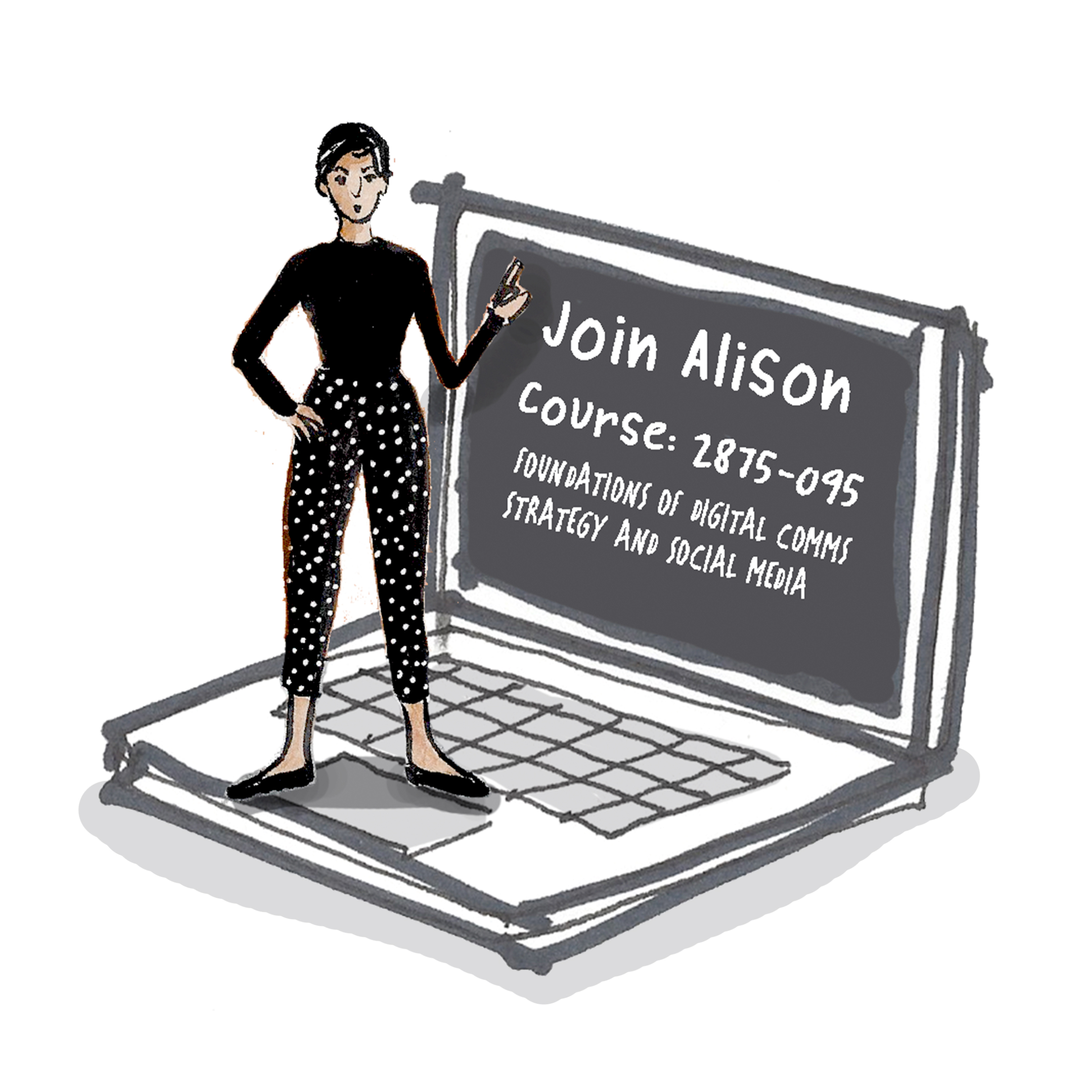 It’s worth repeating: we are all renters on social media platforms, from Facebook to YouTube to Instagram, and even on the straight-laced and seemingly reasonable LinkedIn. Meaning, once you post to any of these platforms, you lose control and copyright over your content — not to mention your ability to organically reach your entire audience.
It’s worth repeating: we are all renters on social media platforms, from Facebook to YouTube to Instagram, and even on the straight-laced and seemingly reasonable LinkedIn. Meaning, once you post to any of these platforms, you lose control and copyright over your content — not to mention your ability to organically reach your entire audience.
So now I’m playing catchup. I’m trying to recreate the Instagram gallery format on my WordPress site.
I’m comparing and contrasting WordPress gallery plugins like Modula and Envira and weeping because they don’t even come close to the gorgeous layouts in Aeolidia (a Shopify design service) or Cargo (not WordPress compatible) or even SquareSpace, all the next best thing to the Instagram format.
Here’s what I mean:
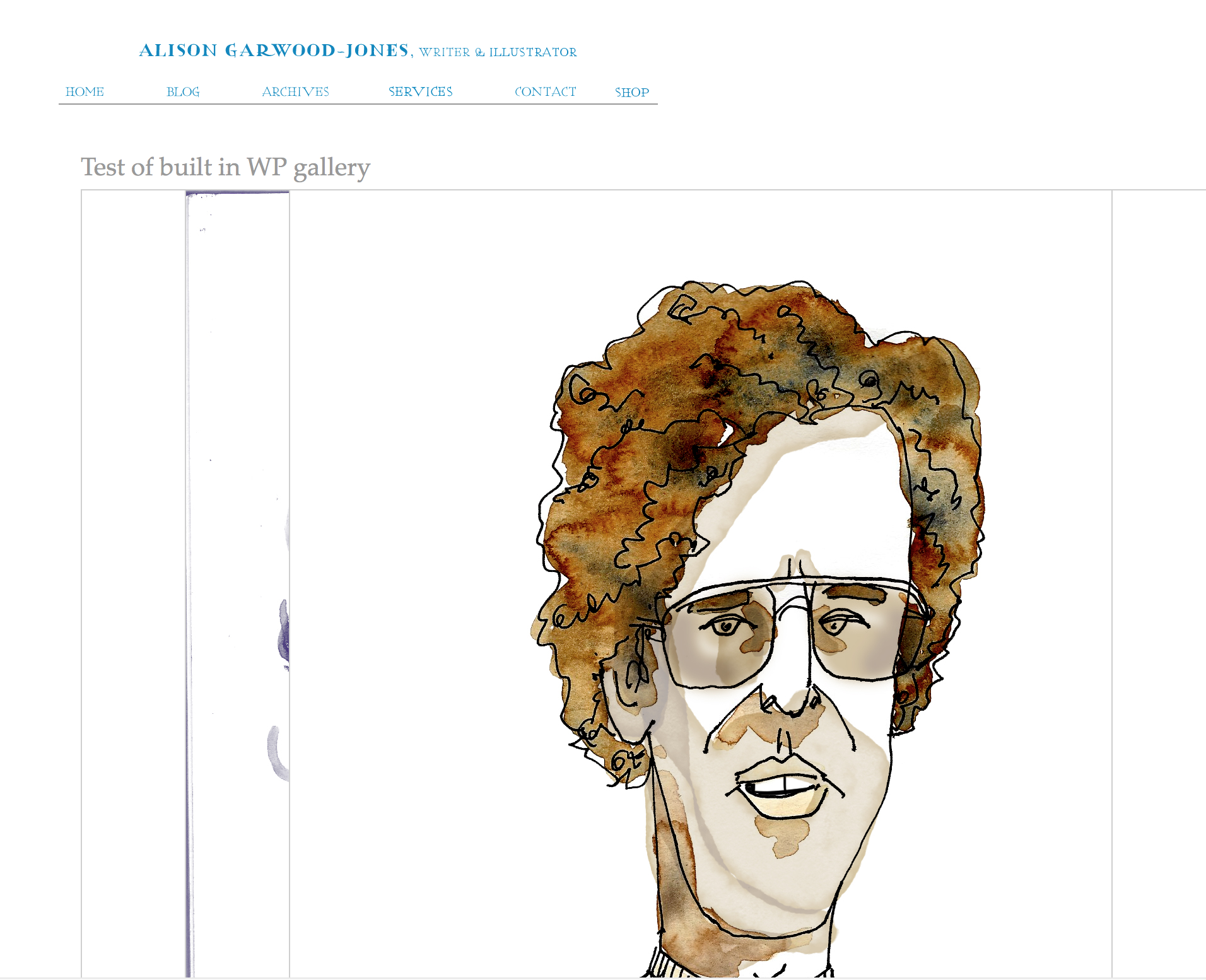

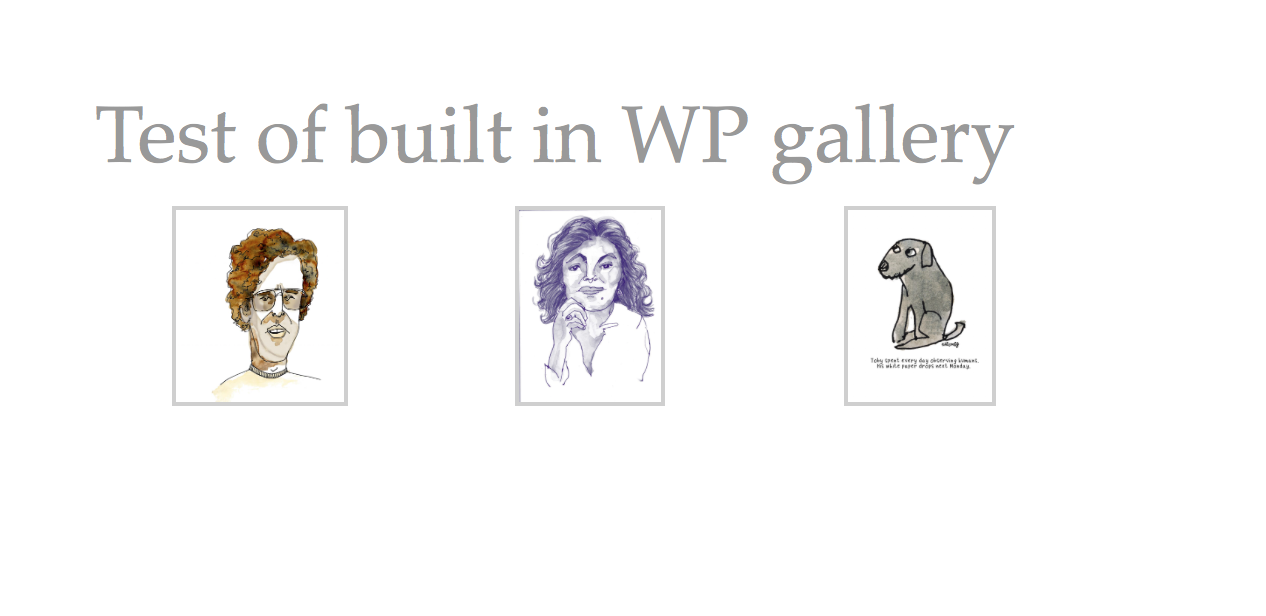
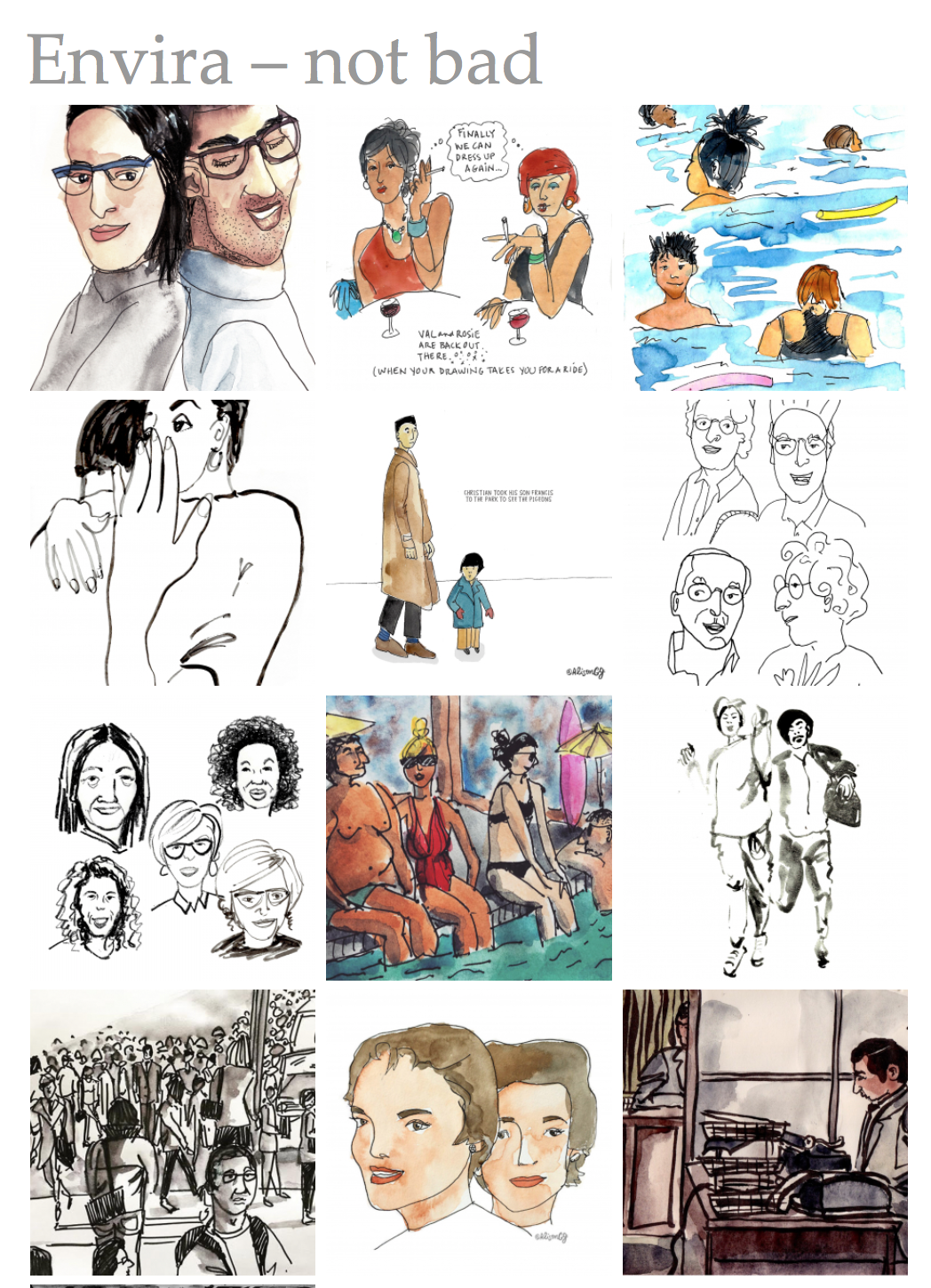
I know what I want and I can lay it out in PhotoShop, but uploading a jpeg showing a gallery images is no way to build your SEO.
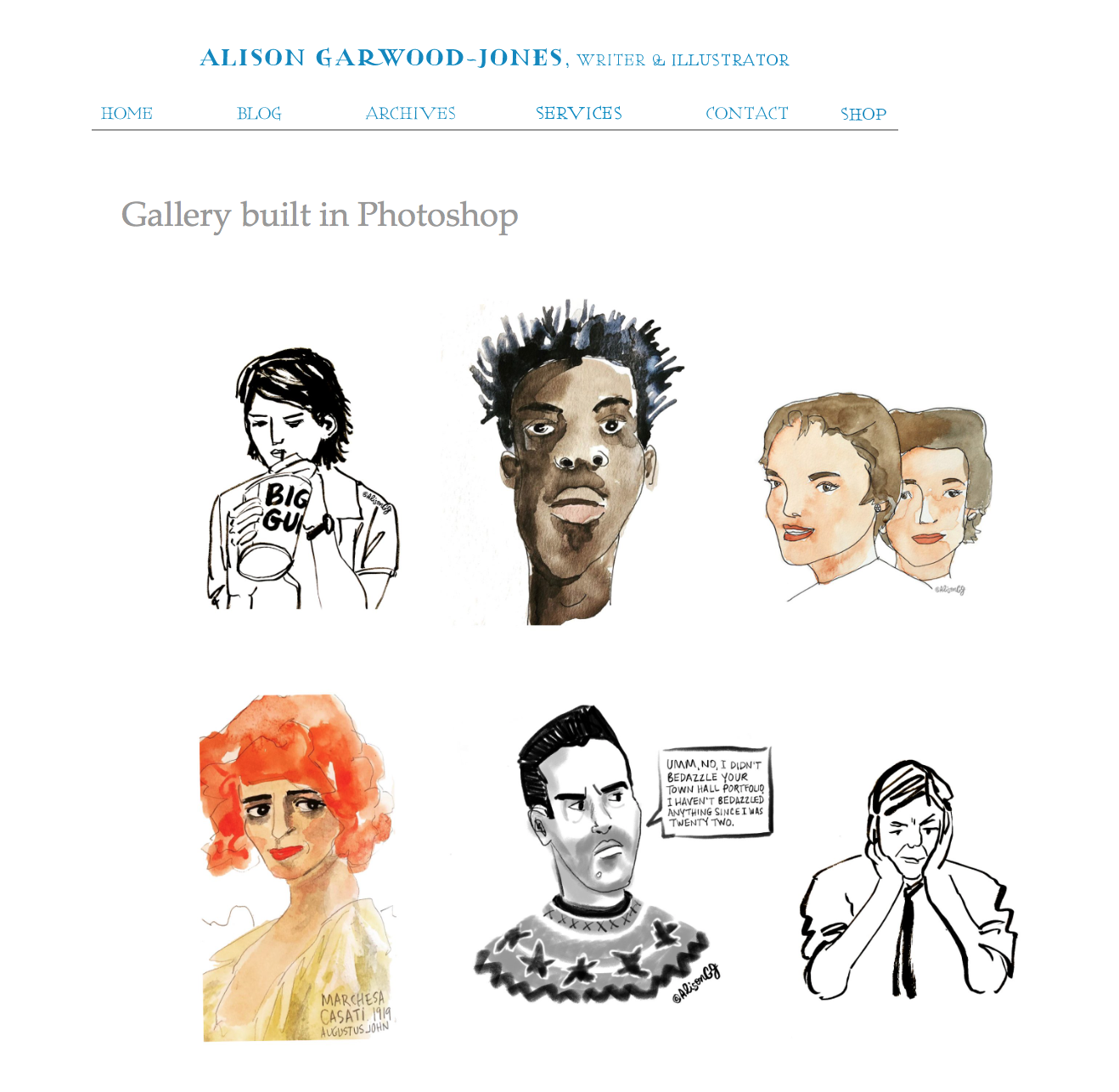
So, it’s back to the drawing board.
How do all of you feel about Instagram going away? Are you as bummed as I am?
Goodbye, Mommy
December 11, 2012
Catherine Lucy Garwood-Jones (1928-2012), Hamiltonian extraordinaire, died on Sunday, Dec. 9 after a ten-year battle with Alzheimer’s. Pre-deceased by her husband Trevor in 2011, Team “Cath and Trev” changed the face of the city they loved so much — he through architecture and she through her commitment to health care, education, music and family.
Catherine’s efforts to secure more funding and improved care for mental health patients across the province gets first billing here. Where others saw stigma, Catherine showed compassion, openness and a determination to see widespread attitudinal change towards mental health, and greater support for families. Volunteering on the Hamilton Wentworth District Health Council (HWDHC) from1976-80, and later with the Hamilton Program for Schizophrenia, Catherine was assigned to head up a community-based board to oversee funding for the first Community Mental Health Program in the province. Colleagues, including Dr. Stan Dermer, remember Catherine storming up the steps of Queen’s Park to lobby provincial Health Minister Dennis Timbrell for more funding. She got it. The “Catherine Garwood-Jones Lecture in Schizophrenia,” part of the Hamilton Program for Schizophrenia (HPS), is a testament to her commitment. This annual event, which kicked off in 1984, attracts leading scholars from around the world to McMaster University every fall.
Catherine did all this while raising three kids and working as the office manager and receptionist at Trevor Garwood-Jones Architects. Her flying fingers typed out the correspondence and specifications for every major design by her husband, including Hamilton Place, The Hamilton Convention Centre, The Art Gallery of Hamilton, and St. Peter’s Hospital.
Born October 22, 1928 in Cape Town, South Africa, the only girl in a family of five boys, Catherine moved with her parents and brothers to London, England after the war. In 1948, while attending the Royal College of Music, a dashing architecture student caught her eye at the Leytonstone Salvation Army Hall in Central London. She was standing on a ladder hanging a poster. They married in 1951 at the hall and moved to Hamilton in 1959 to begin a new life, which was soon to include three children, Peter, Richard and Alison, and years later, a cherished daughter-in-law, Doreen.
Over the years Catherine’s love of music, especially in a venue with great acoustics (like Hamilton Place), was something she shared with Trevor. A longtime member of the Women’s Committee of the Hamilton Philharmonic, Catherine and her husband were regular attendees at concerts and were huge supporters of the arts in all their forms, especially when made by their children.
The family would like to thank their friends and extended relatives for sharing their favourite memories. Special thanks go out to Dr. Kanwal Shankardass and the entire staff at the St. Peter’s Residence at Chedoke for years of loving care. Donations can be made to the Alzheimer’s Society of Hamilton and Halton. Visitation between 10:00 am and 2:00 pm on Friday, Dec 14 at St. Peter’s Residence at Chedoke, 125 Redfern Ave. Hamilton. Private service to follow.
Remains of the day
May 12, 2013
I got a lot of moving feedback the first time I wrote about my mother, Catherine, in The Long Goodbye, published three years ago on this blog. After she died last Christmas, I expanded on the story of our relationship and turned it into a magazine piece for Glow Magazine. It’s in the May issue, on newsstands for just a few more days. Happy Mother’s Day. I dedicate this to Peter and Richard.
 y mother knew her entire adult life what was coming. Confirmation arrived the day she shuffled into the kitchen, swung open a cupboard door, then turned to me and asked, “Where are the singing noodles?” On that day, I stopped leaning on Mum and started extending a protective hand. Before long, pots began appearing in the oven and car keys in the fridge, while Post-it Notes with basic English words multiplied across every surface of the house—all quirks of the onset of Alzheimer’s, the disease that took her mother 30 years earlier.
y mother knew her entire adult life what was coming. Confirmation arrived the day she shuffled into the kitchen, swung open a cupboard door, then turned to me and asked, “Where are the singing noodles?” On that day, I stopped leaning on Mum and started extending a protective hand. Before long, pots began appearing in the oven and car keys in the fridge, while Post-it Notes with basic English words multiplied across every surface of the house—all quirks of the onset of Alzheimer’s, the disease that took her mother 30 years earlier.
Nothing deletes one’s individuality so completely as Alzheimer’s. Its imprint is the same in everyone who gets the diagnosis; they all disappear down the same path, exhibiting more or less the same set of behaviours. Most go from unique citizens of the world to nervous fusspots crying “No! No! No!” (the last word in their drained vocabulary), and then to silent bodies with gaping mouths and fixed stares. That’s why I prefer to think about what made my mother unforgettable, before age flicked a switch and unleashed this great leveller.
For someone born before the Crash of ’29, my mother had a remarkably liberal view of a woman’s place in the world. She honoured the individuality of every soul she met, so unconventional choices—like making art full-time, or not having kids—never sent her into a tailspin, unlike some women in the neighbourhood. In her day, women attached themselves to men like the stateless to lifeboats, their fortunes rising and sinking with their rescuers. All too often, you married the man you wanted to be: aspiring novelists teamed up with writers (becoming their typists, first readers, editors, even ghostwriters), while nurses said “I do” to doctors and vowed to always pass the scalpel but never perform with it. Mum believed in developing a person’s potential, not denying it.
 Catherine, new bride, Summer of 1951.
Catherine, new bride, Summer of 1951.
When I grew up and decided that filling a blank page with words constituted a large chunk of my identity, she was right beside me. During that formative period, she didn’t interrupt my progress to tutor me about men. I now see that was deliberate. Back then, I had no interest in integrating my personal and creative lives. What were guys to books? When we did talk men, she just smiled, looked me straight in the eye and said, “You’ll have to figure that one out on your own.” Confounding, but true.
All the while, she kept feeding my individuality. Every time I came home at Christmas, there was a new book on the end of my bed, touching on one of my interests: painting, history, biography. Those volumes have moved with me to every place I’ve lived in since university: There’s the doorstopper, Paintings in the Musée d’Orsay, the elegant Chinese Brush Painting Techniques and Anne Morrow Lindbergh’s Gift from the Sea, an ode to the forces that shape a woman’s life. Mum owned about five editions of Lindbergh’s book, some with line drawings of shells, others with thick, creamy, deckle-edged pages. When it was revealed several years ago that the author’s husband, Charles, had fathered two families—his famous one with Anne and a secret one with a German hat maker more than 20 years his junior—Mum was too sick to know. But I think I can guess what she would have said, or not said. She wouldn’t have rolled her eyes like a know-it-all or uttered something cynical about men. I’m positive she detected it in Anne’s lucid and compelling writing. Like Anne, pain only increased my mother’s grace.
[pullquote]I said she reminded me of a young Princess Elizabeth: efficient and sensible most of the time, but stunning when you least expected it.[/pullquote]
I don’t know if, as a young woman, Mum fretted about her marital destiny. I never asked. Clever and capable, she could have supported herself teaching piano or assisting a company president. And yet she had a charm and grace that deserved an outlet and some focused attention. When she spread red Max Factor on her lips, she dazzled enough to startle her future mother-in-law to the point of distrust. And more than once, during her younger days in London, England, she tripped up the men she passed on the way to her secretarial job near the city’s Marble Arch. Teasing wasn’t her style, but I’m sure times like that, when she distanced herself from the starched-wimple set, pleased her. I said she reminded me of a young Princess Elizabeth: efficient and sensible most of the time, but stunning when you least expected it. It was hard not to do a double take of my mother when she stained her lips and stood with a drink under a sparkling chandelier, smiling and talking about the things she cared about. Her natural vivacity pulled everyone toward her.
No one knows what Alzheimer’s looks like from the inside out, but Mum gave us a hint. She was acutely aware of everything she was losing and the declarations just poured out in the end. “I want you to be happy,” she said, still not serving up a prescription for how I should get there. “I love that guy,” she stated, smiling and pointing to my dad, sitting next to her in his La-Z-Boy watching the Golf Channel. She must have said “I love you” to him more times in her last year of speech than in the final two decades of their 60-plus years of marriage. Most times, he was too busy staring at the TV—wincing at a missed putt—to hear. But he knew, and we knew, because she was telling the whole world. I’m glad I witnessed this as an adult. The romantic in me wants to believe in love’s power to cut through chaos, disappointment and change.
A few months before we handed Mum over to the care of a team of nurses, she called and left a message on my answering machine. Something in me said, This will be the last time she picks up the phone and dials my number. My hunch proved true. I played her message over and over that week, then popped a blank tape in my boom box and pushed “record,” so I’d have her voice with me forever.
It’s been 12 years since she left that message and I haven’t listened to it since. I can’t. At that moment in time, she put aside her doubt and fear for herself, and with a shaky, lilting voice she said: “I miss you, Alison. I just wanted to let you know I think about you every day and hope that everything’s going well in Toronto. I love you.” From the commotion, I could tell she missed placing the receiver in the carriage on the first try. That vulnerability makes my knees buckle every time I think about it.
Catherine Garwood-Jones died on Dec. 9, 2012, one year after her husband, Trevor.
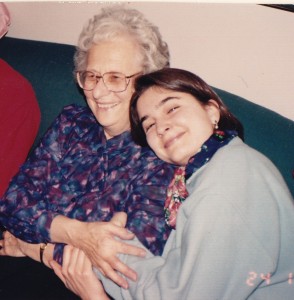 Catherine and Alison hugging (a common pose for us). 1993.
Catherine and Alison hugging (a common pose for us). 1993.
Drop cap by Jessica Hische
Studio Tour of Pen Jar Productions
November 2, 2018
Click on image to play my video greeting, or click here.
An email I sent my contact list on November 1st:
Top of the morning to my friends, family and work colleagues:
For those of you who haven’t heard from me since high school, here’s what’s new: I cut my hair, became an art historian, unbecame an art historian (too academic), pivoted to journalism, let my silver highlights show, wore all black, rediscovered colour, said goodbye to steady journalism work (thanks internet), and hello to content marketing (thanks internet). And when Steve Jobs unveiled the first iPad back in 2010, I rediscovered my childhood love of drawing —first through apps, and then with real paper and paint sets. Art stores are my candy aisle.
Instagram has been a great way to stay in touch with a lot of you through all of our iterations (several of you are getting in on marijuana and bitcoin). Thank you for your enthusiastic feedback on my various comment threads as I explore the possibilities of illustration. It’s because of you — Greg G, Terry L, Isabelle V, Ken H, Caitlin C, Sarah P, Eden S, Martin, W, Maureen J, Gini D, Valerie S, Donna P, and Rona M, to name just a few — that I’ve been able test the market for my ideas, and offer the kinds of illustrations and designs you’d want to live with in your homes. You are my very first customers and cheerleaders, and I am so appreciative.
I made this short video to show you what I’m up to in my sunny apartment. Five months ago, I opened an illustration studio called Pen Jar Productions (read: I added another Ikea desk]. From this simple post, I’ve been making designs for pillows, phone cases, laptop skins, tees, totes, and silky scarves. Hence, my tag line: From My Sketchbook to Your Home™️. I don’t print them myself. A cool POD manufacturer named Notion does the printing and shipping for me.
If you would like to get occasional updates from illustrator me, please feel free to sign up for my Pen Jar Newsletter. Here I will occasionally share new seasonal designs, highlight craft fair appearances, and offer special discount codes for subscribers. You have the option to unsubscribe whenever you want (I take no prisoners).
Now that it’s November 1st, our minds are gearing up for the hunting and gathering of gifts. I know people scratch their heads to come up with original ideas for Christmas, Hanukkah, and the 14 other religious and pagan holidays celebrated in the month of December. And just when that’s over, there are birthdays and Valentine’s Day to think about. The longer you’ve been in a relationship, the harder it is to impress. I’d like to help in that department.
To the first 100 people who sign up for my Pen Jar Newsletter, I am offering 10% off your first purchase. A Discount Code to follow.
Happy Holidays, everyone!
Alison
The rebirth in failure
August 8, 2018
This is post was first published eight years ago. Egads, I’ve been blogging a long time! Some people said it made them feel hopeful — even brave. Your morning dose of hope.
The ability to focus and commit to something through thick and thin is a quality I admire. Writer and comedian Craig Ferguson describes his route to success, saying, “I kept failing until I didn’t.”
But the ability to court failure after experiencing success fascinates me even more. Here are a few examples of established successes who pushed themselves in unexpected directions and put experimentation ahead of standing ovations. For many, confidence didn’t pull them through, feeling lost did. It fueled them to find a new focus in life.
Nicole de Vesian: At 69 she spiraled into a deep depression after the death of her husband. Her friends were scared for her. After a stellar career as a designer at Hermés, de Vesian lost her passion for living and loving, and abandoned the projects piled up on her desk. She left Paris and retreated to Provence, finding solace in the sunlight and flowers of this mythical corner of France.
De Vesian never went back. She changed her focus from luxury textiles to designing gardens and made communing with nature her new life and career. She collected and hauled rocks like some women collect gems, and spent the autumn of her life feeling more alive than she ever had.
Pablo Picasso: He copied the drawings of Leonardo and Raphael with astonishing skill. Everyone cooed he had the makings of a successful society portrait artist. But Picasso struggled. How could he keep exploring naturalism when the world around him looked so ripped and torn to shreds? It was 1914 and Picasso was living in Paris and was too physically weak to join the army. For a man who prided himself on his machismo and physicality, it was an embarrassing blow. Feeling isolated from his family and friends, overwhelmed by the war and bitter and angry over the declining health of a girlfriend, Picasso poured every ruthless emotion he had onto his canvases, turning his fractured sense of self into a new style: cubism.
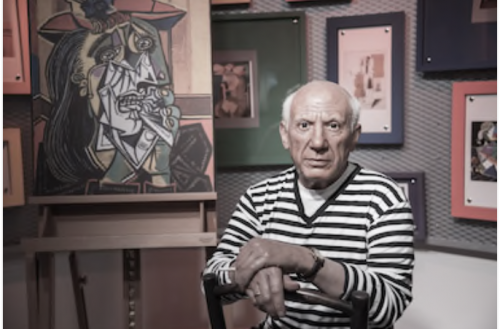
Pablo Picasso in his studio. Source: Shutterstock
Shaquille O’Neal: At 38, basketball great Shaquille O’Neal is preparing to duck under the TD Garden exit sign for good. From what I’ve heard, he has no plans to open a sports-themed restaurant with a 7-foot wax replica of himself at the host stand and signed photos of his game-winning layups over the banquettes. Nor does he plan to become a real estate agent, coach, GM, sports announcer or Shopping Channel pitchman. Nuh uh. “I want to do something bigger,” he told The New York Times Magazine,” last weekend. By the time this MBA (yes, an NBA-er with an MBA) says goodbye, he plans to have defended his Ph.D. thesis from Barry University in Miami, Florida. “My topic is ‘How Leaders Utilize Humor or Aggression in Leadership Styles.'” O’Neal is determined to turn what, for most athletes, is the most depressing time of their life into a period of huge possibilities. Oh, and after he leaves the court, it’s no more “Shaq.” “I’m done with the nicknames,” says Professor O’Neal. Class dismissed.

Shaquille O’Neal dunking. Image: Shutterstock
Michael Kinsley: He quit CNN for what? They’re calling it, “the Information Superhighway.” This was back in 1996, and after 10 years co-hosting CNN’s Crossfire, Kinsley left behind the studio lights and pancake makeup to become the editor in chief of Slate, a journal that couldn’t be bought on the newsstand or bound in volumes at the library; it was only available online. Now why would a Harvard grad, a Rhodes Scholar and a former editor at The Washington Post and The Economist willingly post himself in “Siberia” (that’s what the Worldwide Web was called back then)? Kinsley did it because he trusted his instincts about the internet’s potential, because he knew talent will travel, and because he has the guts to try new things.
Renée Fleming: She’s opera royalty. Last summer, however, Fleming released “Dark Hope,” her first “rock” album. It’s a collection of covers, from Peter Gabriel to Mars Volta. “[I thought it would be] an interesting adventure,” she told the LA Times. “At this stage of my career, I’m facing a kind of maintenance program. I’ve been on this plateau, where there’s no place to go, other than to stretch myself artistically. And this seemed to fit.” Decide for yourself if you like her sound. Either way, you have to admire her courage to sing outside her comfort zone.
Hot off the press
July 20, 2011
If there’s one thing that revs my engine, it’s talking to talented people. I’ve said it before, but I chose to become a journalist so I could engage with the best and brightest on a weekly basis. Talented people are what put the spring in my step and ignite my imagination until my own ideas multiply like popcorn.
Last week I hung out with art director Vanessa Eckstein and writer Marta Cutler, the two principals at Blok Design. Working in advertising they both know the importance of selling stuff. But what they really understand is the importance of selling stuff with meaning, and the more meaning the better.
Of course, when you’re starting out in your career, sometimes you don’t have much choice in the matter. You earn your cheques by going along for the ride.
But most of us reach a point in our lives when meaning, thoughts of our fundamental humanity and the need to figure out how we can attend to the greater good become our main preoccupations in life. Having children will do that to you. So will losing a parent. If you’re lucky, you find a way to adjust your career in line with your values.
Hugh MacLeod has done that. He’s one of my favourite cartoonists. He writes and draws about meaning and how to balance it with capitalism. Hugh participated in the Ted Conference in Edinburgh last week and mused about meaning as it relates to business in one of his email missives from Scotland.
“With many big brands, they don’t really think about the ‘why’ factor. The way it works is that they hire terribly clever folk to come up with tag lines, and then throw lots of money at media. These days, most people see it for what it is.”
Thanks, Hugh, for letting me post your drawing here. I plucked this one from a whole gallery of cool drawings Hugh has done on the back of business cards, many of which have been published in Seth Godin‘s books. Check Hugh out, or better yet, sign up for his daily cartoon here.
But back to Marta and Vanessa, my other two crusaders for meaning. I wrote about them for Applied Arts magazine’s blog this week.
Here’s the post:
Scanning Marta Cutler’s LinkedIn profile is a bit like trying to decide what kind of Christmas present to buy someone who has everything. Sharp of mind and warm of heart, this virtuoso copywriter and twenty-five year veteran of the advertising world has been the creative director at DDB Canada, MacLaren McCann and Cossette Communications. But she waved goodbye to the big agency life last fall— the only life she had known since she was headhunted straight out of the Communication and Design program at OCA (now OCAD) back in the early eighties — and walked into her future with Vanessa Eckstein, the idealistic and intuitive founder of Blok Design, an award-winning boutique agency in Toronto whose ranks have never swelled beyond four staff members.
Cutler and Eckstein met a decade ago when both women worked together as consultants on a film project. Back then, Cutler knew Blok as the agency that had created the simple aesthetic for Caban, the home accessories store that folded in 2006 after Ralph Lauren pulled the plug on it. “I loved the simplicity, elegance and thoughtfulness behind Vanessa’s work,” recalls Cutler. But it wasn’t long after their first meeting that Eckstein moved Blok from Toronto to Mexico City to be closer to her husband, Mexican film director Fernando Arrioja. “In the back of my mind,” says Cutler, “I thought if we collaborated so well once before, a creative partnership might really work some day.”
But it wasn’t until Eckstein moved her family and her studio back to Toronto earlier this year that the two women decided to revisit their creative chemistry. In one of their many conversations over green tea and chocolate, Eckstein talked about the legacy she wanted to leave her six-year-old son and four-year-old daughter. “When she said the word ‘legacy’ it forced me to really think about what I would be leaving my four-year-old daughter,” says Cutler. “I saw the opportunity at Blok as a chance to build something more permanent and more profound.”
Cutler knew that Eckstein was already on that path with long-term projects like Mexico Ciudad Futura, a picture book with punchy graphics that documents the studio’s ten-year collaboration with a team of architects, engineers and environmentalists to rescue the dry lakebed of Lake Texcoco, some 10 km outside Mexico City. The book outlines a plan to reclaim the lake and integrate the ecology with smarter urban planning that scientists predict will reduce airborne pollution around Mexico City by a whopping 30 per cent. Eckstein believes that the addition of Cutler’s directorial experience, broad connections and way with words will help move Blok towards more idea-driven projects and fewer corporate brand identities, which is how she always envisioned her practice as a budding designer.
Cutler agrees. “One of the reasons I was so ready to make the leap from the world I had known and loved for so many years,” says Cutler, “was because in a normal agency life the projects you work on are 80 per cent marketing and consumer-driven, where you’re helping people decide what they’re going to buy, and maybe 10 per cent of your work is developing campaigns that are all about affecting change. Like Vanessa, I really needed to tip the scale. I needed to make it so that 100 per cent of the projects I was working on were very personally meaningful to me.”
And it’s happening. Through Cutler’s connections, Blok recently teamed up with Public to win the business of Partners for Mental Health. “We are in the process of becoming their creative arm along with Public,” she says. Not only is Blok helping to create their brand identity, but Eckstein and Cutler also want to mobilize Canadians to rethink our fear and silence on issues surrounding mental illness. “This is something Vanessa and I both personally care about,” says Cutler. “Right now my daughter is four, but I imagine a time when she’s 10 and mental health is no longer stigmatized in our everyday lives. Then I can sit down with her and say, ‘I had a hand in that.’ That’s the kind of legacy I want to leave her.”
Not surprisingly, female-centred projects also energize this dynamic duo. As the world wakes up to the value of women, and their untapped potential in third world communities, Blok has joined forces with activist Elizabeth Scharpf to create the brand identity for SHE 28, a campaign dubbed “The Menstruation Project.” Through her travels and research in Rwanda, Scharpf discovered that the lack of access to affordable, eco-friendly sanitary products meant that girls and women were missing about five days a month of school and work.
To alleviate the embarrassment and stigma of their monthly flow, Scharpf worked with engineers at MIT and the University of North Caroline to develop a biodegradable sanity pad made from banana leaf fibres, a more comfortable option than the rags, bark and mud they were using before. Blok is doing the branding for the initiative they’re calling “The Launch Pad,” including the design of the packaging.
“Women are the key to improving Africa’s most impoverished communities,” says Cutler, and with her involvement in Blok’s new direction, the studio’s efforts to make change for the greater good will continue to grow.
2010 Roundup
December 29, 2010
The scariest post to write
My best posts are usually the scariest to write. I’ve found that the more scared I am about the content, the more likely I am to connect with my readers because we all struggle with the same stuff. But there’s a fine line between tacky confessionals and honest storytelling. Maybe that’s the source of my fear: misrepresenting my emotions and experiences. Being tacky and flippant is easy. Being real is hard.
And it’s never easy writing about members of the opposite sex when you’re simultaneously trying to attract them.
The wackiest post
Shortly after I got my new iPhone.
The fluffiest post
I love talented illustrators.
The most ‘Wow, life is awesome ‘ post
Travel is like a “big bang” explosion of the heart and mind.
My most popular health post
Sleep deprivation is huge.
My most popular design post
Bruce Mau has a lot of followers.
My most misunderstood post
Looking through the feedback to my site in Google Analytics I discovered that people thought I was saying, “Feminism is bad” and “Feminism is wrong” (these are just two examples of key word search terms typed in by readers). What I was really trying to say is that feminism is as flawed and occasionally misguided as every other form of human expression. It’s a work in progress.
And this post was my attempt to say that female empowerment is more tied to the spirit than the flesh. When Sheila Heti wrote in How a Person Should Be that “Every age has its art form. The nineteenth century was best for the novel, but today we live in an age of some really great blow job artists,” she captured something true about the tenor of our times.
The post with the most comments
Talking about my Mommy, as I liked to call Catherine G-J, was the easiest post I ever wrote. It didn’t require coming up with an idea. I just remembered. You may be wondering, how is your mother? “The same. Worse,” is how my family has taken to describing her when friends and family ask. Every time I visit my mum in hospital, she has sunk deeper into her wheelchair. This Christmas made me cry even harder. I can’t hold her hand anymore. They’re bonier than ever, and she has them locked together in a nervous knot. It would take a wrestler to pull them apart. With hands clasped, eyes looking skyward and her mouth wide open, you’d think she was praying or in some sort of religious ecstasy. Whoever said life is a wheel was right. We get on, go around and get off so someone else can take our place.
What will your legacy be?
November 8, 2010
*9:00 am: This post is dedicated to my friend, Monica Scrivener. She died on Saturday. I found out ten minutes ago on Facebook. In high school, Mon and I used to sit beside each other in art class and make smartass comments. I’m heartbroken.
When I’m dead and all physical reminders of the life I built have disappeared under the pile-up of stuff from future generations, I’ll live on, for a while, in the minds of my family, friends and ex-boyfriends. But they’ll die too and take their memories of my voice, my bent and signature scent with them. The biggest cache of information will go down with my parents and my brothers. Then where will I be?
I suppose my name will linger on for a little while longer inside my high school, on the gym walls that show I played for this team and won that award. And, of course, I’ll live on in cyberspace, endorsing a lip balm (good grief), interviewing an expert, cheering on a friend and calling out to my lost mother.
My blog will just stop. But it will never suffer the fate of print, curling at the edges or turning yellow with age. Like a fresh sheet of paper, it will be as crisp and clean as the day I launched it.
At first, people will think I’m too busy to post and my page views will drop to zero. The odd person might check back in to see if I’ve cobbled together a new entry. And if they’re really committed to this site (or me), they’ll do a Google search of my name, stumble upon my obit and go … “Oh.”
Elsewhere in cyberspace, my face and name will pop up in the “People You May Know” columns in LinkedIn and Facebook. Requests will go out, but my silence will hurt my future job and social prospects. Meanwhile, the lineup of guys in my eHarmony account will be several miles long and administrators will shut down my page for “lack of activity.” The question, “Who does she think she is?” will shoot through at least one male heart because I didn’t even try to strike up a conversation with him.
But, half a moment! I still have some more time to make hay in my personal and professional lives. So, IF I’m lucky enough to reach old lady status, here’s what I hope my legacy will be after I collapse in a heap for the last time.
… agj …
She lived an unconventional life for someone with some pretty traditional values.
She was afraid of dying which made her unafraid of living.
She hated interruptions when she was in The Zone.
Loud noises irked her too.
She had the courage to say “No” to marriage until, one day, she had the courage to say “Yes.”
But, even then, she still lived through herself.
She let her hair show its first lashings of grey and opened to the idea of becoming a Silver Belle
Keeping in mind, Nature always prevailed.
At 80, she was at her most liberal (and, no, it wasn’t too late)
She spent the money she saved on dye jobs and bought books, presents, fresh flowers, and paid her property taxes.
She found plenty of ways to mother young people without ever seeing her feet disappear behind her belly.
She cried when her friends described their losses and left behind Kleenex balls for them to pick up.
She lived a highly engaged life and negotiated the “me time” it took to achieve that with mixed results.
She negotiated her “us time” with equally mixed results.
She was a sponge for love, and she’ll miss you.
A lot.
This post is part of a blog series on BrazenCareerist.com being sponsored by Entrustet. Ryan Paugh sent out emails to Brazen members asking us to answer the question, What do you want your legacy to be?
Red Alert
October 1, 2005
Say goodbye to the rosy sting of rosacea with the latest at-home treatments.
There was a time when the blush on a woman’s cheek inspired sonnets and royal weddings. But a persistent ruddy complexion definitely goes against the feminine ideal. Rosacea is a progressive and cumulative skin disorder that starts off as a diffused redness, then, little by little, distorts the evenness of your complexion. It affects more than two million Canadians, most of them fair-skinned women over the age of 25.
What’s up, doc?
There is no rhyme or reason as to when, why or whom rosacea hits, says Dr. Anne Curtis, a Toronto-based clinical dermatologist who heads up the Dermatology Laser Centre at Women’s College Hospital in Toronto. “But people with rosacea appear to have a different flush process that may be activated by a number of factors — from extreme weather, spicy foods, hot drinks, pollution and excessive exercise to increased stress.”Any one of these triggers, by themselves or in combination, may enlarge the blood vessels in the face and keep them open. The result is skin that is swollen, hot and painful to the touch and, if left untreated, plagued by a trail of pimples. However, before rosacea sufferers identify their triggers, usually through the help of diaries, they often get misdiagnosed. “For the longest time, I just thought I had acne, but that wasn’t the real problem,”says Lisa Roy, 35, a Toronto-based customer relations manager who was diagnosed with rosacea a year ago. “I had teenage acne, but my pimples changed as I got older; they went from being spots I could pop to these closed-off hard bumps under my cheeks and chin.”Roy tried everything, including combinations of intense moisturizers and benzoyl peroxide, to reduce the parched redness and treat the acne. Instead, she ended up with very confused skin. “I didn’t need to dry the pimples because the problem wasn’t acne.”
To the rescue
If caught in time — as soon as you notice persistent redness and before the onset of spider veins in the face — you can decrease or prevent the development of the pimple stage.
There are a number of treatments available that can diminish the symptoms of rosacea, each with their own formula for decongesting and strengthening fragile blood vessels and hydrating dry skin. La Roche-Posay’s Rosaliac Anti-Redness Skin Perfecting Daily Moisturizer, when used twice a day, is especially effective in treating thin, reactive skin in the early stages of rosacea. This moisturizer has the added benefit of a green tinted cosmetic cover-up to help hide the redness. DDF’s Redness Relief is another good early-phase therapy that contains a number of plant-based derivatives, including yeast extract for calming, horse chesnut extract for reducing inflammation and toning blood vessels, and cocoa extract for increasing circulation. Emollients like these may also be used as adjuncts in severe cases of rosacea where topical creams or oral antibiotics are prescribed.
B. Kamins, Chemist, a Montréal-based company that specializes in stubborn skin care problems, recently introduced a line of products especially formulated for rosacea-plagued complexions (Bill Clinton and Jennifer Jason Leigh are said to be loyal fans). The Booster Blue line — which includes a cleanser, mask, treatment and moisturizer — contains a patented Bio-Maple compound to help moisturize and relieve inflammation. The treatment can be reapplied over makeup while the moisturizer has the added benefit of SPF 15, not to mention a distinctive blue-green optic to cosmetically neutralize even the most intense blush.
Stay the course
Don’t expect results overnight. Caring for rosacea is about committing to a program. “We’re aiming for control, not a cure,”says Curtis. However, following a skin care regimen is worth the effort. “It took a couple of months for me to notice a difference,”says Roy, “but when I did, it changed how I feel about myself.”








